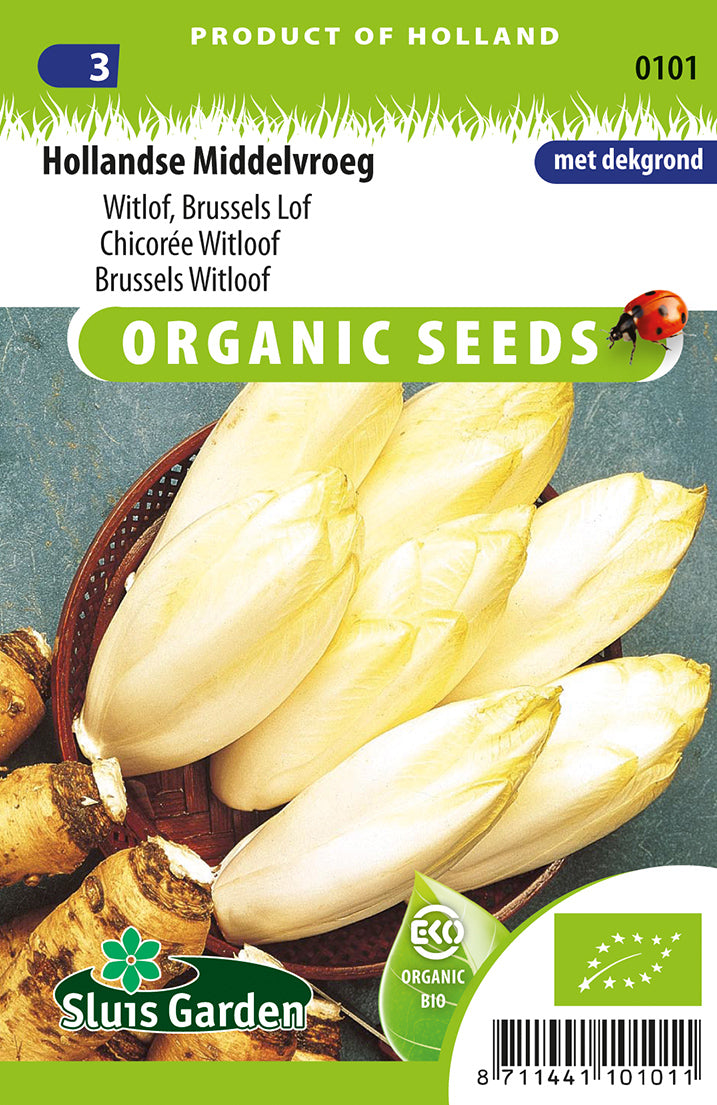1
/
of
1
Brussels Witloof Hollandse middelvroeg BIO
Brussels Witloof Hollandse middelvroeg BIO
Regular price
1.350 KWD
Regular price
Sale price
1.350 KWD
Unit price
/
per
Shipping calculated at checkout.
Couldn't load pickup availability
"Witloof" typically refers to Belgian endive or chicory, and "Hollandse Middelvroeg" suggests a specific variety of chicory that is medium early. Growing Brussels Witloof, or Belgian endive, involves two distinct stages: cultivating the roots, and then forcing the blanched heads. Here's a step-by-step guide:
**1. Planting the Roots:**
- **Timing:** Plant the roots in late spring or early summer.
- **Soil:** Choose a well-draining soil with a slightly acidic to neutral pH (around 6.0 to 7.0).
- **Planting Roots:** Plant the chicory roots about 6-8 inches apart and bury them in the soil. The tops should be just below the soil surface.
**2. Growing the Roots:**
- **Watering:** Keep the soil consistently moist throughout the growing season.
- **Fertilizing:** Apply a balanced fertilizer or compost to the soil to promote root development.
- **Hilling:** Around mid-summer, begin hilling soil around the base of the plants to blanch the stems. This involves covering the bottom part of the plant with soil to keep it from turning green.
**3. Harvesting the Roots:**
- **Timing:** Harvest the roots in late fall or early winter, after they have experienced a period of cold weather.
- **Lifting Roots:** Carefully lift the roots from the soil, and remove any excess soil.
**4. Forcing the Heads:**
- **Storage:** Store the roots in a cool, dark place until you are ready to force them.
- **Forcing:** About 20 days before you want to harvest the Witloof heads, plant the roots close together in a dark and cool place, like a basement or cellar.
- **Temperature:** Maintain a temperature of around 50°F (10°C) during the forcing period.
- **Darkness:** Keep the roots in darkness during the forcing period to encourage the development of the characteristic white heads.
- **Harvesting:** Once the heads have formed, cut them off at the base.
**5. Culinary Use:**
- **Fresh Consumption:** Witloof heads can be used fresh in salads, as a side dish, or in various recipes.
- **Storage:** Store Witloof heads in a cool place or refrigerator until ready to use.
**6. Overwintering:**
- Some gardeners choose to leave a portion of the roots in the ground over winter, covered with mulch, for an early spring harvest.
**7. Pests and Diseases:**
- Keep an eye out for common garden pests and diseases. Proper sanitation and pest control measures can help ensure a healthy crop.
By following these steps, you can successfully grow Brussels Witloof Hollandse Middelvroeg and enjoy the delicate, blanched heads in your culinary endeavors.
**1. Planting the Roots:**
- **Timing:** Plant the roots in late spring or early summer.
- **Soil:** Choose a well-draining soil with a slightly acidic to neutral pH (around 6.0 to 7.0).
- **Planting Roots:** Plant the chicory roots about 6-8 inches apart and bury them in the soil. The tops should be just below the soil surface.
**2. Growing the Roots:**
- **Watering:** Keep the soil consistently moist throughout the growing season.
- **Fertilizing:** Apply a balanced fertilizer or compost to the soil to promote root development.
- **Hilling:** Around mid-summer, begin hilling soil around the base of the plants to blanch the stems. This involves covering the bottom part of the plant with soil to keep it from turning green.
**3. Harvesting the Roots:**
- **Timing:** Harvest the roots in late fall or early winter, after they have experienced a period of cold weather.
- **Lifting Roots:** Carefully lift the roots from the soil, and remove any excess soil.
**4. Forcing the Heads:**
- **Storage:** Store the roots in a cool, dark place until you are ready to force them.
- **Forcing:** About 20 days before you want to harvest the Witloof heads, plant the roots close together in a dark and cool place, like a basement or cellar.
- **Temperature:** Maintain a temperature of around 50°F (10°C) during the forcing period.
- **Darkness:** Keep the roots in darkness during the forcing period to encourage the development of the characteristic white heads.
- **Harvesting:** Once the heads have formed, cut them off at the base.
**5. Culinary Use:**
- **Fresh Consumption:** Witloof heads can be used fresh in salads, as a side dish, or in various recipes.
- **Storage:** Store Witloof heads in a cool place or refrigerator until ready to use.
**6. Overwintering:**
- Some gardeners choose to leave a portion of the roots in the ground over winter, covered with mulch, for an early spring harvest.
**7. Pests and Diseases:**
- Keep an eye out for common garden pests and diseases. Proper sanitation and pest control measures can help ensure a healthy crop.
By following these steps, you can successfully grow Brussels Witloof Hollandse Middelvroeg and enjoy the delicate, blanched heads in your culinary endeavors.
Share

